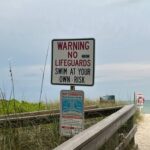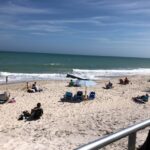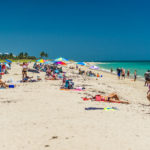VERO BEACH — The Heritage Center concluded an exceptional 75th anniversary year by honoring the Carter Family at the 11th Annual Pioneer Family Recognition Dinner. A sold-out crowd packed the landmark building for the celebration, which yearly recognizes the contributions of Indian River County’s earliest residents.
The event feels somewhat like a big family reunion. Intermarriages between the early families were frequent, and multiple generations of the Carter family, past recipients, next year’s honorees, and friends were all on hand to reminisce and catch-up with one another. Previous honorees included the Sexton, Schumann, Michael, MacWilliam, Graves, Helseth, Vocelle, Zeuch, Cox/Gifford and Holman families. The delightful Helen Glenn, daughter of Alex MacWilliam, Sr., said her father moved to Vero Beach in 1919 to build the Riomar section of Vero Beach. He eventually served as Mayor for 20 years and as State Representative for 10 years. Growing up in Vero, Helen was a particularly energetic force behind a number of community programs and served for 27 years on the Indian River County Mosquito Control Board. She and friend Alma Lee Loy remain very active with the Veterans Memorial Island Sanctuary Advisory Committee.
The Zeuch family was recognized in 2007 and Warren Zeuch told me his grandfather was one of the town’s founders, arriving in 1909.
“At the 90th Anniversary of the City last October, our family was celebrating its 100th year,” said Zeuch. “My grandfather gave the property where the Heritage Center is located.”
The Schlitt family will be recognized at the 2011 Pioneer Dinner.
“Leo and John Schlitt used to chauffer families from Cleveland and Chicago to Vero Beach,” said John Schlitt. “They went back to Missouri and told their families, “This is paradise” and moved here in 1918.”
The family purchased large parcels of land, and branched out into insurance, real estate, architecture and contracting fields.
Sean Sexton, whose family was the first Pioneer Family to be recognized, said that R.D. Carter could be considered Vero’s patriarch.
“Time in Vero Beach can be measured as BC, before Carter and RD,” quipped Sexton. “He laid out the Indian River Farms District land and all the drainage canals that made the land arable.”
Before introducing Marvin Carter, who would speak on behalf of the Carter family, Heritage Board President Elizabeth Graves Bass stressed the significance of membership in the organization saying, “It’s not just supporting a deserving building; we are preserving our heritage.”
After introducing and acknowledging Carter family members and friends in attendance, including his siblings Robert D. Carter III, E. Stanley Carter and Joye Carter Brooks, Marvin gave a brief history of the Carter family legacy.
The area’s population was quite small in 1911 when R.D. (Robert Daniel) Carter arrived, as an engineer for the Indian River Farms Company. His first assignment was to assess whether a 55,000 acre parcel of land could be drained and developed.
“The water was anywhere from six inches to three feet deep,” said Carter.
Following R.D.’s encouraging report, the land was purchased at three dollars an acre and the process of designing and constructing the drainage system, and laying out the Town of Vero began.
R.D. moved his wife Lillian and two children Egerton Everett “Ed” and Blanche to land he had purchased in Wabasso. In addition to his engineering business, he adapted to the area’s other major industries, dairy, cattle and citrus farming.
Together with his partner Harry W. Damerow, the Carter and Damerow Engineering Firm designed the original city of Vero Beach, the original wooden bridges to the Barrier Island, what is now State Road 60 and many other local areas.
“Ed [Carter] saw his first alligator in Pocahontas Park, and later was a key engineer in the firm during the boom years of the 1920s,” said Marvin Carter of his father.
Ed and his wife Gertrude “Shug” would have three sons, Robert D., Marvin E. and E. Stanley, and two daughters, Mildred “Millie” Carter (Bunnell) and Joye Carter {Brooks}.
Carter related a story about the firm designing the drainage system for what would eventually be come Sebastian, saying, “It was during prohibition and they found that every little creek had moonshine stills.”
Marvin continued the family’s engineering tradition and joined the firm. “Next year the firm will celebrate 100 years of service; turning swamp into the land we enjoy today.”
Carter then introduced Debra Frasier, who spoke on behalf of her mother, the late Millie Bunnell. Millie’s husband George Bunnell had been instrumental in the development of the Environmental Learning Center; earlier in the day, Frasier had attended the dedication of it’s newly rebuilt Discovery Station. And Millie was the leading force behind saving the Heritage Center from demolition.
“Millie and George often had dueling projects,” said Frasier with a laugh. “This morning I was at George’s project and now I’m at Millie’s project. I do not think this is a coincidence.”
Frasier entertained the crowd with a pictorial history of The Dolphinettes, a synchronized swim team comprised of high school girls that Millie formed in 1951. The Dolphinettes became so admired that they were frequently photographed for tourism purposes. They appeared in shows all over Florida and even as far away as New York City. “They spent their lives as boosters for this community,” said Frasier.
“Millie’s two major projects were The Dolphinettes and the Heritage Center. The Heritage Center in 1990 was known as the Physical Arts Center and Millie read in the paper that the City was going to demolish the building, as it was no longer needed,” Frasier related.
She formed a political action committee and not only saved the building from demolition, but also enlisted the support of the community to rebuild it and give the historic Heritage Center a wonderful new life.
Frasier closed with what she said her mother would want her to say, “Keep an eye on preservation. And get out your checkbooks to make sure that this remains open for future generations.” {igallery 192}






